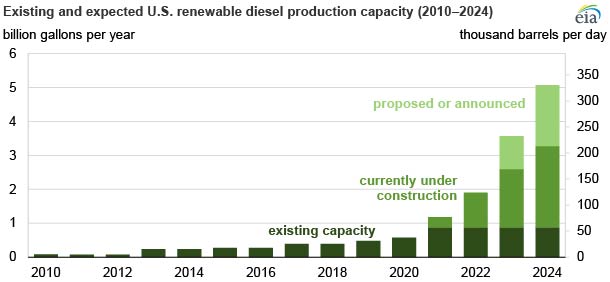
U.S. production capacity for renewable diesel could increase significantly through 2024, based on several announcements for projects that either are currently under construction or could be in development soon. This growth is driven by higher state and federal targets for renewable fuel, favorable tax credits, and the conversion of existing petroleum refineries into renewable diesel refineries.
As of the end of 2020, U.S. renewable diesel production capacity totaled nearly 0.6 billion gallons per year (gal/y), or 38,000 barrels per day (b/d). Several projects currently under construction could increase this capacity by 2.4 billion gal/y; proposed and announced projects would add another 1.8 billion gal/y by 2024. If all projects come online as intended, U.S. renewable diesel production would total 5.1 billion gal/y (330,000 b/d) by the end of 2024.
Despite growth in renewable diesel production, renewable diesel will make up about 5% of current U.S. diesel production capacity by 2024 if all estimates of proposed renewable diesel capacity expansions occur as planned and petroleum diesel refinery capacity remains largely unchanged.
Renewable diesel is a renewable fuel that is chemically the same as petroleum diesel and nearly identical in its performance characteristics. Renewable diesel can be blended into petroleum diesel at any level, making it different from biodiesel, which can only be blended at rates between 2% and 20% of diesel fuel by volume.
Renewable diesel receives some of the most favorable greenhouse gas (GHG) reduction scores among existing programs, such as the federal Renewable Fuel Standard (RFS) and the California Low-Carbon Fuel Standard (LCFS). As a result, participants in those programs are increasingly using renewable diesel to meet rising renewable fuel targets.
Although most new capacity for renewable diesel will be on the West Coast, some announced projects are on the Gulf Coast. California and other western states such as Oregon and Washington will likely consume the majority of renewable diesel produced on the Gulf Coast to meet future LCFS program targets in those states.
Several former petroleum refineries plan to begin producing renewable biodiesel. Marathon Petroleum’s refinery in Martinez, California, plans to start producing renewable diesel in 2022 and could reach its full production capacity of 730 million gal/y (48,000 b/d) in 2023. Phillips 66’s Rodeo Renewed project in San Francisco, California, plans to produce 800 million gal/y (52,000 b/d) of renewable fuels when completely converted in 2024. If realized, this project would be the world’s largest facility of its kind.
One of the primary risks to the expansion in renewable diesel production capacity is the availability of fat, oil, and grease feedstocks. Prices for most renewable diesel feedstocks have increased as renewable diesel production has increased. Biodiesel and renewable diesel producers have been relying on incentives such as the biomass-based diesel tax credit and tradeable credit prices for renewable diesel in the RFS and LCFS to make a profit. Feedstock availability and government incentives will likely continue to play a role in the financial viability of new renewable diesel production capacity in the near term.

Follow us on social media: